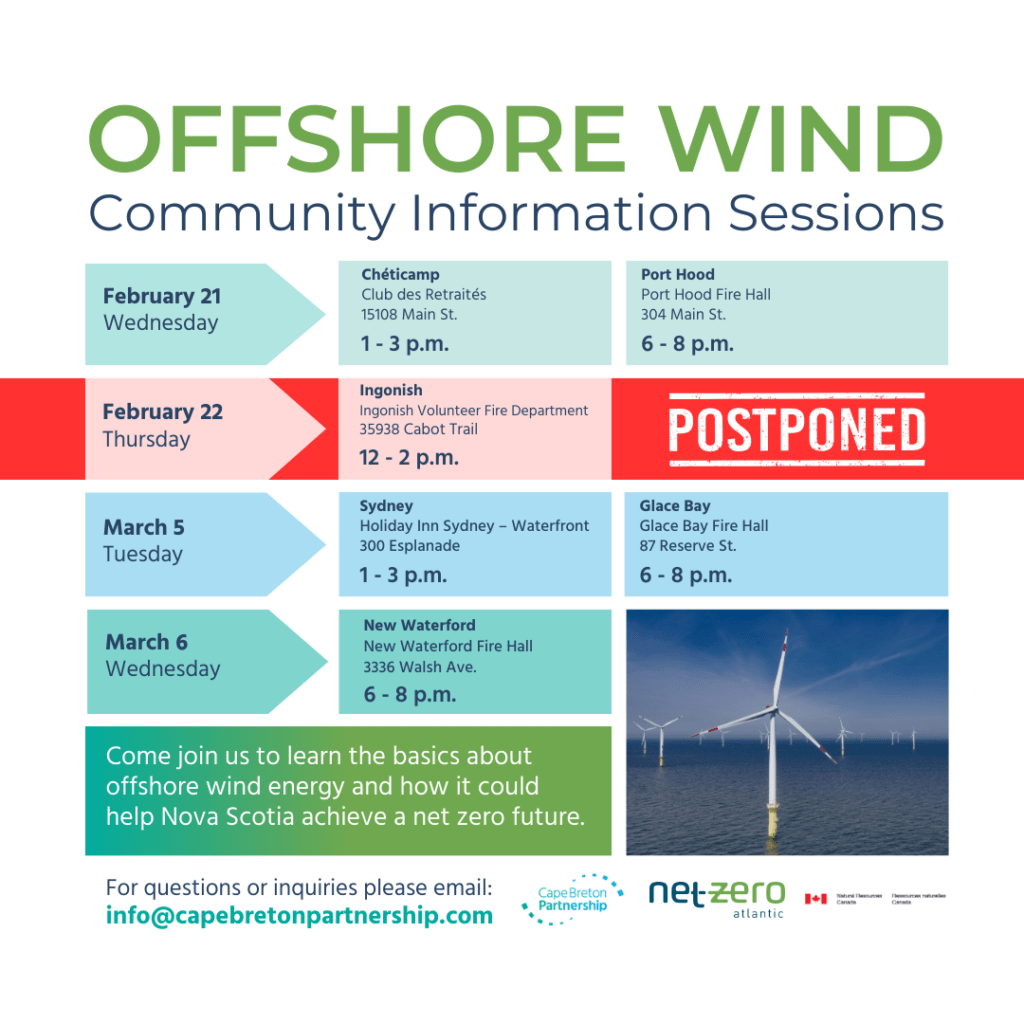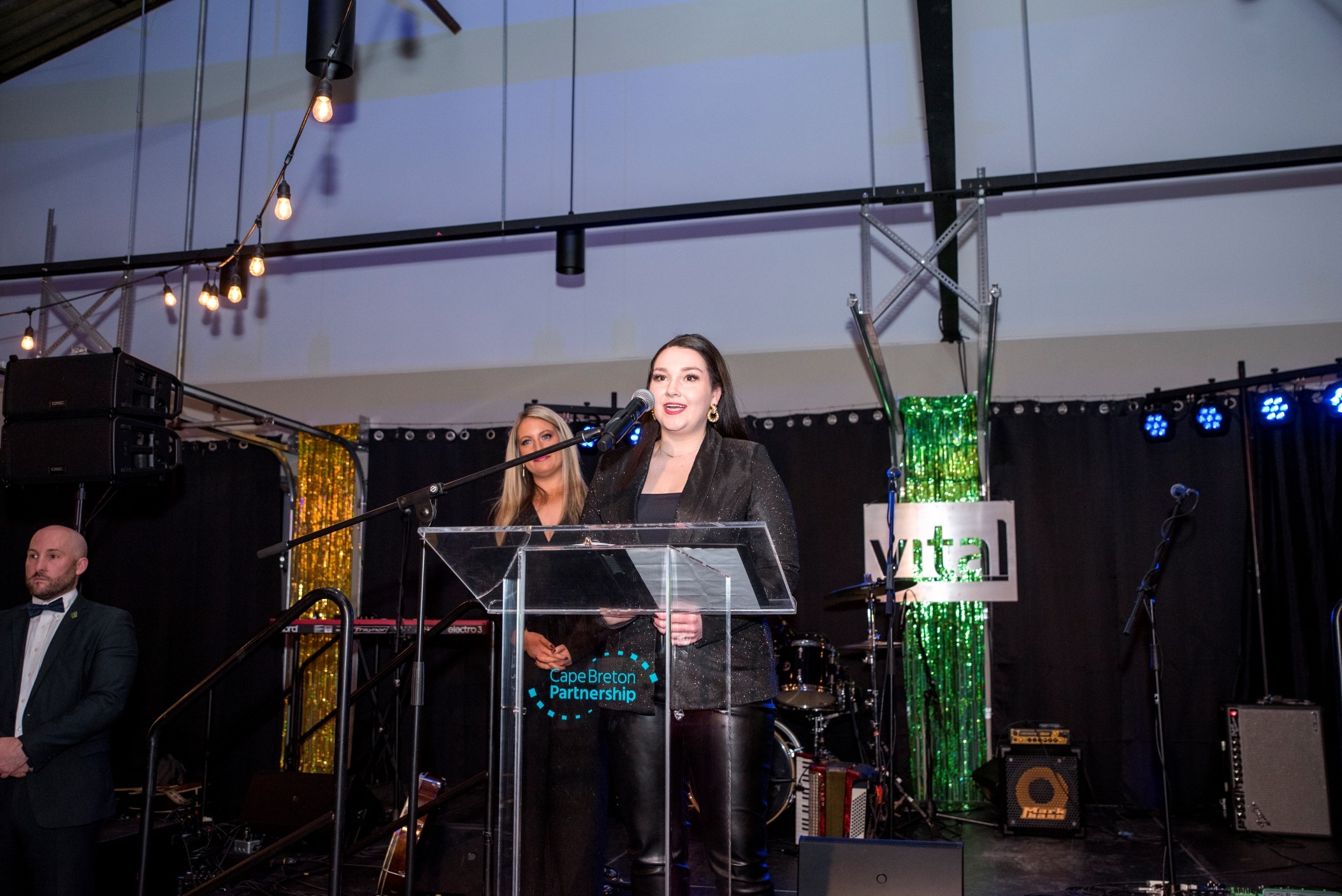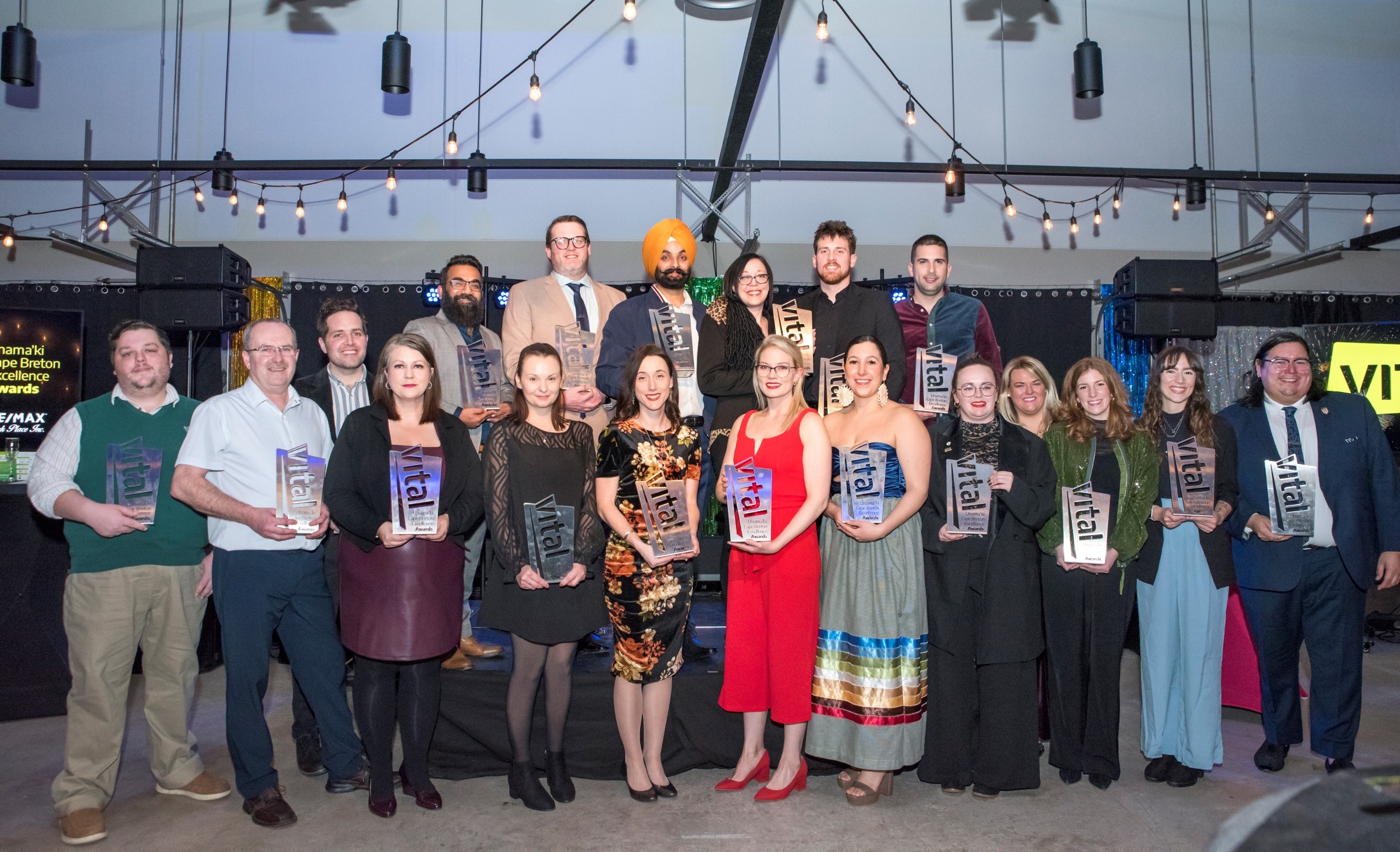Canada’s housing crisis is dominating the news, but we rarely hear about the work happening behind the scenes to fix it. There are housing advocates, developers, and politicians right here in Unama’ki – Cape Breton who are making tangible progress towards solutions.
In the fourth episode of Invest in Cape Breton, we cover the current state of Cape Breton’s housing market, what two developers are doing to address the crisis, and what they think local governments and stakeholders can do to facilitate more housing development.
Our guests are:
- Roger Boutilier, CEO, Nova Scotia Association of Realtors (NSAR)
- Doug Doucet, CEO, Doucet Developments
- Darla Gaudette, Business Development, Doucet Developments group of companies
- Bobby Dubeau, President, By the Bay Properties
- Mario Vetro, Co-Founder, By the Bay Properties
This episode is sponsored by the Construction Association of Nova Scotia (CANS) and Doucet Developments.
Listen now, or read on for a few highlights.
Population Growth and Lack of Inventory Are Driving the Local Housing Crisis
Unama’ki-Cape Breton saw a population boom during the pandemic that hasn’t let up. There are many upsides to growth, but the island doesn’t have enough housing to support it yet. As a result, availability is low and prices have gone up.
Roger Boutilier from the Nova Scotia Association of Realtors (NSAR) says the way out of the problem is to build more, especially in the categories of social housing, senior housing, starter homes, and density development (i.e. row houses and apartment buildings). The good news is that Nova Scotia has the most new development in the country. The situation should improve in the next few years as those projects come to market and prices and interest rates stabilize.
New Housing Developments Are Coming Soon
Doucet Developments is deep in the design phase for new residential and commercial development coming to the Sydney waterfront. The first phase of Edgewater is expected to deliver 166 luxury apartment rentals, office space, community amenities, and 400 parking spaces. The company is also hoping to build residential communities behind the Ben’s Bread facility on George Street, and is exploring opportunities on Charlotte Street as well.
By the Bay Properties is new to the region but is already providing housing. They have 40 affordably-priced mini homes on the way and hope to deliver 80 units by the end of 2024. In the near future, they’re focusing on government programs to provide affordable housing (join the waitlist) and getting permits to build multi-unit buildings.
Governments Are Doing a Good Job Addressing the Crisis, but Can Still Do More
All of the guests offered kudos to local, provincial, and federal governments for making the housing crisis a top priority.
As for what else they can do to spur housing development, Vancouver-based By the Bay Properties would like to see the out-of-province property tax cancelled. Doucet Developments would like to see incentives like bonuses, tax breaks, and a streamlined permit process. NSAR would like to see governments and developers working together to build more social, senior, and higher density housing.
Subscribe to the Invest in Cape Breton podcast
In Episode 5 we’re talking to tourism innovators. Subscribe or follow now on your favourite podcast platform to be notified when it drops. If you’re enjoying the series, consider leaving us a rating or review.
February 21, 2024 Update:
The Offshore Wind Information Session currently scheduled for February 22 in Ingonish has been POSTPONED. The Cape Breton Partnership and Net Zero Atlantic are presently working to reschedule the session to provide an opportunity for key stakeholders to attend and participate.
The sessions scheduled for February 21 will still be taking place as planned.

February 7, 2024 Update:
Due to significant weather events impacting the region in early February 2024, the originally scheduled Offshore Wind Information Sessions were postponed. New dates have now been confirmed, and the Information Sessions will be taking place across Unama’ki – Cape Breton from February 21 – 22 & March 5 – 6, 2024.
Original January 26, 2024 News Release:
Cape Breton Island, NS – The Cape Breton Partnership and Net Zero Atlantic have announced a second round of Offshore Wind Information Sessions across Unama’ki – Cape Breton in early February 2024. The goal of the sessions is to invite residents to come and learn the basics about offshore wind energy and how it could help Nova Scotia achieve a net zero future.
“The first round of sessions late last year was well-received by communities in Unama’ki – Cape Breton, and we want to continue that momentum in 2024 by visiting more communities with our partners at Net Zero Atlantic,” says Tyler Mattheis, President & CEO of the Cape Breton Partnership. “We want to learn alongside the communities we’re visiting. We are sharing information and asking that the community share their thoughts and concerns about offshore wind development with us to help inform regulatory decision making.”
The Government of Nova Scotia has set a target to develop 5 GW of offshore wind energy by 2030. Nova Scotia currently has an electricity generating capacity of 3.061 GW. The regulations for the industry are being jointly developed by the Government of Canada and Government of Nova Scotia, with the Regional Assessment for Offshore Wind Development in Nova Scotia ongoing.
“Net Zero Atlantic is looking forward to continuing our work with the Cape Breton Partnership for these information sessions. We hope to see community members interested in learning more about why we need to achieve net-zero emissions and how offshore wind could help our region reach this target,” says Sven Scholtysik, Director of Research at Net Zero Atlantic.
The information sessions are a collaboration between the Cape Breton Partnership’s Green Energy Engagement Program and Net Zero Atlantic’s project Capacity Building for the Sustainable and Inclusive Development of Nova Scotia’s Offshore Wind Resources.
Upcoming sessions are scheduled in the communities of Chéticamp, Port Hood, Ingonish, Sydney, New Waterford, and Glace Bay. To learn more, including session dates, times, and locations, please visit: https://capebretonpartnership.com/windinfo.
-30-
Media Contacts:
Carly Appleton
Cape Breton Partnership
902-562-0122
Carly@capebretonpartnership.com
Kasia Morrison
Net Zero Atlantic
KMorrison@netzeoatlantic.ca
902-410-6325
About the Cape Breton Partnership
The Cape Breton Partnership is Unama’ki – Cape Breton’s private sector-led economic development organization that supports companies and entrepreneurs by promoting our island as a great place to live, work, and invest; growing a culture that values and celebrates creativity, innovation, and entrepreneurship; and connecting entrepreneurs and companies to the resources they need to succeed. For more information, visit https://capebretonpartnership.com.
About Net Zero Atlantic
Net Zero Atlantic seeks to advance the goal of a sustainable and inclusive transition into a carbon-neutral future in Atlantic Canada. We produce credible and objective data to inform sound policies and decisions related to critical topics currently including, but not limited to, hydrogen, offshore wind, geothermal energy, and energy system modeling. Learn more about Net Zero Atlantic at www.netzeroatlantic.ca.
Cape Breton Island, NS – NextGen Unama’ki – Cape Breton and the Cape Breton Partnership were thrilled to celebrate the 2023 Vital Unama’ki – Cape Breton Excellence Awards recipients on January 26 at the Port of Sydney’s Royal Cape Breton Yacht Club Room.
The Vital Awards annually recognize youth and young professionals across Unama’ki – Cape Breton who have made significant contributions to their community, school or workplace, and the employers who support them. This year marked the tenth anniversary of the Vital Awards, and winners from the past ten years were celebrated at the after party featuring music from Rankin MacInnis and the Broken Reeds.

“The Vital Awards was an inspiring night celebrating outstanding youth and young professionals,” shares Genevieve Andrea, Chair of NextGen Unama’ki – Cape Breton. “Recognizing excellence in six categories, we amplified the voices shaping our vibrant community. As we approached this year’s awards, we reminisced on the remarkable successes of winners from the past decade. Now, I’m genuinely excited to witness the promising journeys that lie ahead for this year’s winners!”

“Each year, we come together to celebrate the energy and potential of our youth, the dedication of employers, and the leadership in our community,” shares Tyler Mattheis, President and CEO of the Cape Breton Partnership. “It’s crucial to acknowledge the incredible value these individuals bring to Unama’ki – Cape Breton, and the employers that give youth opportunities to grow and succeed locally. We take great pride in our ongoing partnership with NextGen Unama’ki – Cape Breton for this event, as we contribute to conveying the message that the youth of our Island are vital.”

The 2023 Vital Award Winners are:
Vital Excellence Award – Recognizes individuals who have played a vital role in their community through volunteerism, culture, leadership, innovation, etc:
- Peter MacInnis
- Saralyn Gillan
- Ethan Merlin
- Chloe MacDonald
- Paige Cox
Vital Employee Excellence Award – Recognizes employees who have played a vital role in their workplace in Unama’ki – Cape Breton:
- Shane MacSween, New Dawn Enterprises
- Nicole MacDonald, YMCA Cape Breton
- Melissa Vickers, Cape Breton Regional Chamber of Commerce
Vital Employer Excellence Award – Recognizes employers who have played a vital role in creating rewarding employment opportunities for youth in Unama’ki – Cape Breton:
- Anchored Ideas
- Boys and Girls Club of Cape Breton
- AB Mechanical
Vital Newcomer Excellence Award– Recognizes newcomers who have made significant contributions to a community or communities in Unama’ki – Cape Breton through leadership, mentorship, entrepreneurship, etc:
- Ankit Wadhwa
- Tam Campbell and Julia MacMillan
- Gunny and Guntas Brar
Vital Entrepreneur Excellence Award – Recognizes visionary entrepreneurs whose significant contributions have played a pivotal role in propelling economic growth, all while exemplifying the qualities of effective leadership:
- Basil Doucet
- Meghan Finney
- Hazel Sparling
Vital Lnu’k Excellence Award – Recognizes Lnu’k who are outstanding ambassadors of culture, community, and collaboration on Unama’ki – Cape Breton:
- Kalolin Sylvester
- Armand Paul
To learn more about each winner and their contributions to communities across the Island, visit http://www.cbnextgen.com/winners.
-30-
Media Contact
Jeremy Martell, Director of Communications
Cape Breton Partnership
jeremy@capebretonpartnership.com
902-562-0122
About NextGen
NextGen Unama’ki – Cape Breton envisions a network of young, community-minded professionals that contribute to socio-economic prosperity, fair equality of opportunity and community development through leadership and innovation. To realize this vision, we engage young professionals in dialogue and inspire them to become more active in all aspects of the future of their communities. With our partners, we identify and promote advancement opportunities for young people.
About the Cape Breton Partnership
The Cape Breton Partnership is Unama’ki – Cape Breton’s private sector-led economic development organization that supports companies and entrepreneurs by promoting our Island as a great place to live, work, and invest; growing a culture that values and celebrates creativity, innovation and entrepreneurship; and connecting entrepreneurs and companies to the resources they need to succeed.
On January 30, 2024, the Cape Breton Partnership, through the Building Tomorrow Campaign, hosted Service Nova Scotia and Procurement Assistance Canada for an informative virtual session, via zoom, exploring the topic of procurement and selling to both the Provincial and Federal Governments.
If you’re a business wondering how to sell your product or service to either the provincial or federal government, this is the session for you! In this session, attendees received insights into the steps and systems of the procurement process and strategies for successfully engaging with government.
Speakers from the Government of Nova Scotia and the Government of Canada dive into a range of topics as they provide guidance to local businesses navigating the complexities of government procurement. The session aims to equip participants with the knowledge and tools essential for effective engagement with the government procurement process.
This session is hosted by the Cape Breton Partnership’s Building Tomorrow Campaign, in collaboration with Service Nova Scotia and Procurement Assistance Canada.
*Disclaimer: This session occurred on January 30, 2024, and included information that was accurate as of the time of presentation. As circumstances and projects continue, there may be a variety of details and pieces of information that will deviate from the information in this recording.
(Originally published by Invest Nova Scotia)
At the intersection of critically needing to reengineer a petroleum-free bioeconomy and sustainably feeding the world’s population, there is a huge pipeline of potential solutions. While there is no lack of ideas, there is a lack of resources to get those solutions — all of which require capital-intensive infrastructure and investment — into the marketplace.
Located in Cape Breton, Nova Scotia, the Verschuren Centre is uniquely equipped to scale ideas and innovations, as well as address some of the most critical challenges facing the world today.
We spoke with four people who work closely with the Verschuren Centre to ask why the sector is exploding in popularity and how the Verschuren Centre and its partners help take cleantech companies from start to scale.
A beacon in a world demanding change
Paul Richards, Manager of Agtech & Industrial Biotech at Invest Nova Scotia, doesn’t mince words when describing the current climate.
“Cleantech, sustainability, and low carbon are the conversion points of rethinking how we structure a new bioeconomy and feed the nine billion people living in the world by 2050. Both of those challenges are converging and creating great opportunities for innovation.”
“This is a sector prime for disruption. The world and the markets are demanding change. That’s where innovators and entrepreneurs live and want to focus, where solutions are global, and opportunities are great. These are transformative opportunities for innovators and ecosystems that embrace these changes and want to be part of the solution.”
“The organizations that take hold of these changes and recognize the transformation taking place will be the leaders going forward because it’s not a want-to-have, it’s a need-to-have. That’s where the opportunities lie.”
Jennifer Fuccillo is an Investment Associate at Invest Nova Scotia. She explains from an investment lens that what used to be a vertical has become a horizontal, meaning cleantech plays across most, if not all, sectors.
“Sustainability continues to become more and more prominent across the investment landscape, and Nova Scotia is well-positioned to play a leading role in such investments. Supporting these investments is a win-win-win — we can grow our sustainable economy, support meaningful impact on society and the planet and make financial returns for the province all at once.”

Perhaps no one is better suited to speak to the sheer volume of potential cleantech solutions and companies than Beth Mason, President and CEO of the Verschuren Centre.
“The focus on sustainability has been around for a long time and it’s ever-increasing. As a result, you’ve got all these cleantech companies developing solutions. So, there’s a big pipeline of potential solutions. Now, we need to get those into the marketplace. We almost have a backlog of solutions, yet there’s more every day, which is an amazing thing.”
“We’ve never advertised, yet we have companies from all over calling us, and that’s just word of mouth. We’re looking for companies that have gone past TRL4, have been through an accelerator, and either have a potential for angel investment or already have investment.”
“We want to know, is the solution viable? Who’s buying? Have you already engaged with the end buyer? Does the solution fit one of our companies in Nova Scotia or companies in our ecosystem? We like them to be far enough down the de-risking pipeline that if we put all this investment and effort into them that it’s likely to pay off.”
Commission a 10,000-litre reactor line for biomanufacturing
Unlike other industries, cleantech needs capital-intensive infrastructure to scale. The Verschuren Centre provides access to a shared infrastructure that is unique and novel within North America.
“If you’re making a new green chemical or graphene, you need investment in big equipment. You can’t just do that from your basement. And that’s the stage when the Verschuren Centre picks up companies. We try and build either collectively with the company a shared asset, or we build — in the case of biomanufacturing — the asset that can be used by multiple companies. That’s the de-risking role of the Verschuren Centre,” explains Mason. “We’re a not-for-profit, so we’re not rolling in money to do that. We’ll partner with those companies, and then stack funding around it, which helps to minimize their investment to get to the next stage of growth.”
“We’re hoping to commission our 10,000-litre reactor line for biomanufacturing this summer. That completes the journey to scale for a lot of our biomanufacturing companies. It’s a one of a kind in Canada and that attracts international clients and keeps our pipeline of clients moving to full scale while they build their plant, hopefully in Canada.”
“It’s a $10-million investment. This helps our clients move from the current pilot we’ve got, which is 1,000 litres, up to 10,000. In the next two years, our goal is to add decarbonizing technologies to our manufacturing, which would translate for other companies in other sectors. It’s a marriage of our energy side with our biomanufacturing side.”
It’s a $10-million investment
Richards echoes the importance of access to not only infrastructure, but capital in general. “Deep technology requires a lot of capital investment. It’s a little bit of the chicken and the egg, where companies don’t have the equipment, capacity, or infrastructure to produce and scale at the level investors and corporate partners want. But they need that investment and market pull to get the investment.”
Dispersa is a client at the Verschuren Centre making biosurfactants from food waste to replace the $45-billion petroleum-derived market. They began scaling their automized process at the Verschuren Centre this past summer. They have exceeded expectations and already moved from a three-to-five litre reactor up to their first 100-litre reactor run, which was completed in January 2023. This provides Dispersa with enough sample product to secure additional large commercial partners and exemplifies the speed start-ups can achieve at the Verschuren Centre.

Nivatha Balendra is the CEO and founder of Dispersa. “We are involved with the Verschuren Centre through our production stream. Since we started Dispersa, we’ve been developing our process at the lab scale. When it came time for us to scale up our production, we struggled to find the right fit — finding partners who really understood our process who have scaled before, but who also understand the industry challenges — timelines, expectations of clients, and the market.”
“It was challenging to find people who really understood it from the business lens, as well as having all the equipment under one roof. As you can imagine, it is super-expensive to have all these reactors. Purchasing downstream equipment as an early stage start-up is just not feasible. Having the right partner with all these resources, coupled with experience, is what we were looking for.”
Read about Dispersa in Forbes: Dispersa Raises $3 Million & Seeks To Transform Clean Tech With Sustainable Biosurfactants
Create industry-specific programs
AscendBio is an ag and industrial biotech scale-up program that enables companies in the industrial biotech and agritech sectors to scale up their technologies and business operations. It brings together the Verschuren Centre’s scientific and technical expertise and infrastructure, along with Invest Nova Scotia’s sector expertise, business support and international networks.
Companies that join receive support to achieve technical milestones, raise the capital required, garner market insight, connect with potential customers and partners and join a community of like-minded companies. They can grow faster with less capital.
“AscendBio provides start-ups with investment readiness support when needed. This support might include fine-tuning their pitch deck, helping them define milestones or determining how much they should raise. When a company is ready to raise a round of financing, we work with them to secure this investment, whether it’s an investment from Invest Nova Scotia or connecting them with other investors — or both,” says Fuccillo.
The objective of AscendBio is to examine the challenges facing these disruptive technologies to help companies progress through the technical stages towards commercialization.
“I always say we want to create bridges, not wharfs. If we only take companies half the way, then we haven’t fulfilled their mission, and we haven’t fully captured the value proposition they have as economic development opportunities. We want to have those companies scale up and achieve their investment potential,” says Richards.

“AscendBio support services involve a tremendous amount of commercial grade infrastructure, and that is what leap frogs start-ups through that valley of technical difficulty. All along, we’re able to support the stages of growth by connecting them to investment, and connecting investment technical milestones to financial milestones, so the companies are raising money at the appropriate stages.”
Balendra echoes the effectiveness of this unique approach. “Paul Richards was our champion in helping us get into the Nova Scotian landscape and getting connected with the right people. We were a part of AscendBio at the same time as being introduced to the Verschuren Centre. They really complemented each other because after that, we also applied for Invest Nova Scotia’s GreenShoots program. That was kind of our first entry point into understanding the different stakeholders in the province.”
“What we try to do is create the winning conditions and the value prop that we brought to companies to want to jump into this ecosystem. Every development, every service delivery, every company needs a value prop. We can help companies go from angel [funding] rounds to Series A with less money required. We do that because of that shared infrastructure and that team-oriented approach,” says Richards.
Build a province-wide supportive and flexible ecosystem
Not only does the Verschuren Centre bolster economic development in rural Nova Scotia, but it also supports the growth of venture grade companies following the power law curve, which means everyone has the potential to create an outsized number of jobs and returns for investors. This is on top of the use of local feedstocks and other resources. The Verschuren Centre is a key player in attracting and building the pipeline of innovative and sustainable start-ups in Nova Scotia.
“We are an independent not-for-profit, but we operate as a service-based model. And because we’re a not-for-profit, we can offer a smorgasbord of opportunities for companies. We’re not an incubator, but we operate like an open-access facility. You can build your team here. You can access our labs. We pull a lot of resources from our partners for companies when they come in. It’s a unique business model that’s hard to find anywhere else. This is a big attraction for companies from across North America and it really builds on the strengths of Nova Scotia,” says Mason.
You can build your team here
“We must think of our region as an ecosystem, a destination, a beacon. Our core objective is to create the value proposition where companies say, ‘That is the place where you do that type of business,’ whatever it is. That’s what we want to replicate in Nova Scotia — where companies from outside are attracted because it has the winning conditions,” says Richards.
“Because we focus on venture grade opportunities, companies have the potential to see a billion-dollar opportunity. They have the potential to disrupt verticals and have a touchpoint of billions of people. Since our lens is on disruptive technologies and disruptive companies, it’s exciting to see the collection of companies that have that level of impact. These are not just innovative companies with innovative products. These are companies that have the potential to disrupt the vertical and play a significant role.”
“We’ve built an ecosystem responsive to industrial biotech companies, that understands their milestones. We’ve built a financial continuum that helps companies move through it and understand the stages of growth better and faster.”
Make it happen quickly
Speed matters — moving through the stages and delivering on a product impacts investment decisions.
“We want companies to demonstrate technical milestones, and they do that through iteration. They’re able to work on the equipment. They have more run times and have more access to testing and utilization of specialized equipment that a private sector company, or a company not connected to a Verschuren Centre or Verschuren Centre-like organization, wouldn’t have,” says Richards.
Fucillo expands: “The Verschuren Centre is unique in that they take no equity from the company, and they have teams and expertise to fill in gaps often present in very early stage technology start-ups. This helps to move companies forward faster and with less capital than they would otherwise require — good for companies and investors alike.”
Balendra has seen the impact of this focus on speed. “They just have an amazing team there. We work with the fermentation team — they’re just pushing things along on time. It’s incredible what they’ve built, and it deserves to be featured and shared more for people to recognize just how excellent the service and the value is.”
Looking ahead and keeping the ball rolling
The word is out and AscendBio is growing fast.
“Precision fermentation demand has exploded, and this is an area of our investment portfolio we plan to expand. At the same time, AscendBio and the Verschuren Centre are focusing on expanding other key strategic areas, such as carbon transformation — also areas of interest for Invest Nova Scotia. Like other sectors, the plan is to gradually build a diverse portfolio of agtech and industrial biotech companies across various stages of growth and sub-verticals,” says Fuccillo.
“You can’t find it anywhere else in Canada. That’s the novelty of it. You’ve got lots of universities that generate innovation, but never materialize it. That’s the difference. They don’t have an interest, let alone the capacity, to scale up clean tech. Their interest is in research and that’s great, but when they exit university, where do they take their technology?” says Mason.

“This last year, our first companies from Toronto reached Series A [funding] and are now deploying with partners in Nova Scotia. Kraken Sense, AlterBiota and Cotex are partnering with large manufacturers, which ultimately is where we want that technology to get to — uptake of their product and the ability to build their first plant.”
Richards summarizes the importance of building the ecosystem and the positive outcomes. “Our objective is to continue to enhance our relationships in the investment community. The pandemic in some ways was a great equalizer. Everyone was communicating on the phone or on Zoom. We had equal opportunity to tap into the financial ecosystems and financial markets. Companies were able to access, and we were able to facilitate relationships with San Francisco, Boston, India and Toronto that changed the way start-ups finance their growth.”
“Mobility of money has changed in the last three years. We need to further enhance those relationships so other investors see the value prop of capital efficiencies, velocity, and an overall supporting ecosystem. They start seeing their money being better utilized and better deployed by tapping into the AscendBio and the Verschuren Centre value proposition and services.
“Nova Scotia is never going to be big, so let’s get good at being small. We know the winning conditions a company needs to fall in love with Nova Scotia. They’re going to fall in love with the research collaboration, where they know this is how they’re going to build their technology platform. They’re going to fall in love with feedstock producers. They’re going to fall in love with a market opportunity or an offtake agreement with a large corporate partner. And they’re going to fall in love with the talent and teams they develop here. Our objective is to really anchor and weave those pillars into their corporate strategy. That’s how we build and maintain the winning conditions.”
The Green Harbour Project — a partnership between the Verschuren Centre and Irving Shipbuilding. The Green Harbour Project in Halifax Harbour is a collaborative endeavour aimed at achieving net-zero emissions in port operations by 2050.
Dispersa is just one success story out of AscendBio and the Verschuren Centre.
“The Verschuren Centre has been an excellent partner and nothing short of amazing for us. We’re so happy to be able to work with them. Countless people over our production capacity search recommended the Verschuren Centre to us. Naturally, we reached out to them, and it’s been amazing since. From the day we had our first contact, it’s been so efficient and incredible what they’ve been able to help us with as we scale. That really solidified for us that we found the right partner and allowed us to then think about our expansion in Nova Scotia.”
“We’re now partnered with the Verschuren Centre, and we want to grow this partnership in the long term for many years to come. We really feel like they are now a core part of Dispersa in many ways. We consider their team our team, and that’s really what it comes down to.”
“We can’t do any of this without having the support of the Verschuren Centre, AscendBio, and Invest Nova Scotia. They give us the resources to do what we do. Ultimately, we’re thrilled to be able to provide this ingredient and see it as a real product on the shelf. It’s a full-circle moment for us and at the end of the day, contributing to a sustainable future is why we do what we do.”
Become an Insider
Get the latest updates from Invest Nova Scotia including events, resources, and stories about doing business in Nova Scotia and around the globe.
